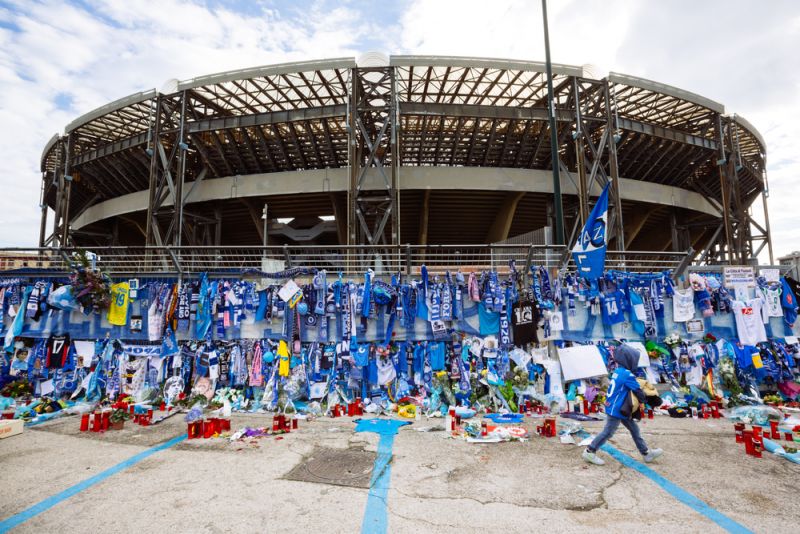
Building Belief: Maradona, Naples, and the REMNaNTS OF MEMORY IN bUILDINGS
By: Javier Garcia

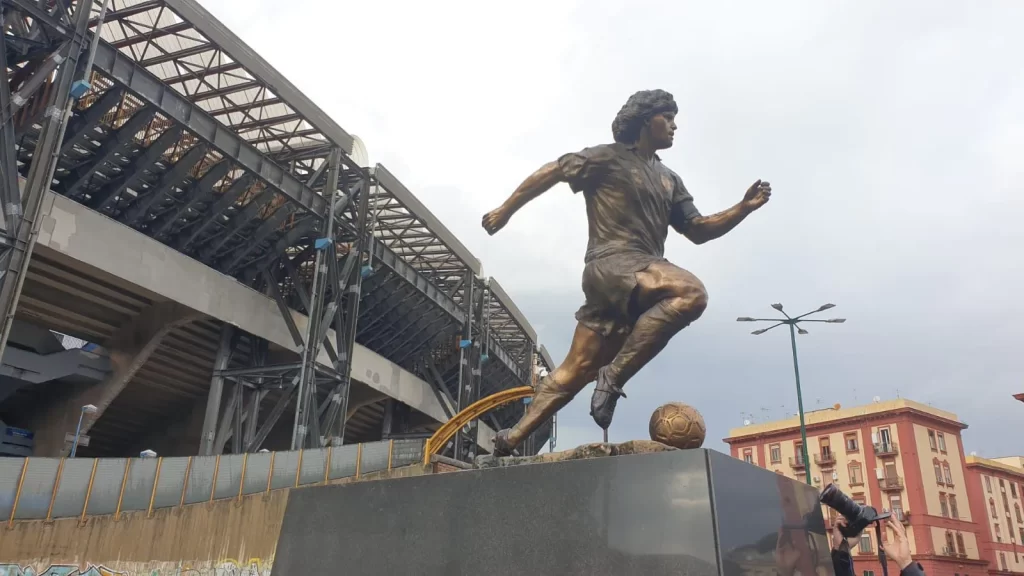
Maradona’s Iconography
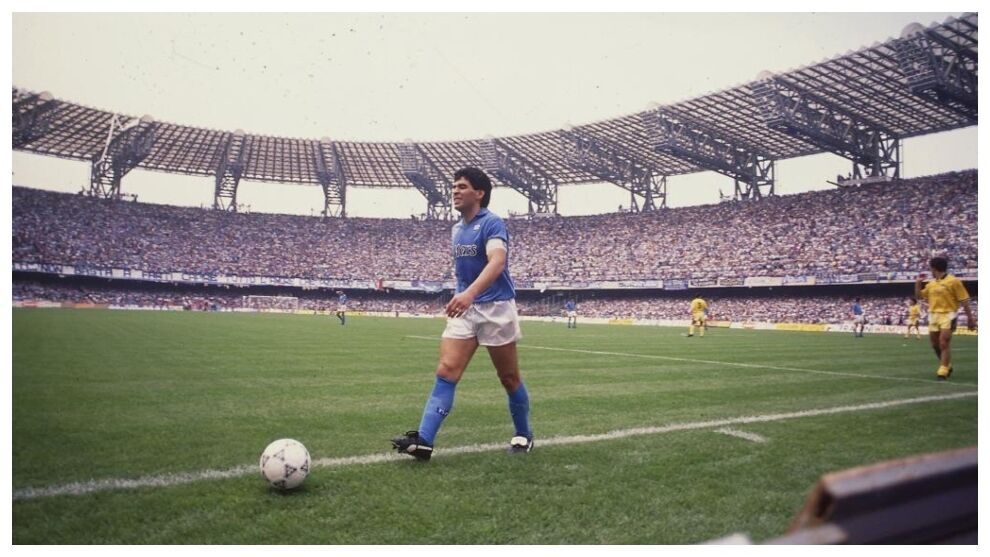
Maradona arrived in Napoli in 1984, marking a turning point for the club and city which was facing both economic and social hardships. During his time at Napoli Maradona became a symbol of hope and revival for the Neapolitans. His larger than life persona transcended football, affecting the local culture and identity of Neapolitans as his presence in the city led to a surge in pride and self identification among the locals. His success on the Napoli team created statement of hope and defiance against the more affluent northern Italy during a time where southern Italy felt left behind after the Italy’s reunification.
Source: Reuters
Maradona’s success marked the most successful era for the Napoli Football team, winning two Serie A titles and a UEFA Cup. He created a football fever so profound and so contrasting to the situation of the city of Naples that he became a part of the city’s identify and his success was always seen as reflective of the narrative of the city itself. This engrained Maradona as a figure that galvanizes pollical sentiments and local pride to a point where local politicians vied for an association to him as that would result in support for them from the Neapolitans in elections.
Source: Reuters

Maradona’s time in Napoli meant more than just a player to the fans, in this video we see how the deep connection within the people of Naples and Maradona was.
Memories captured in space
In her capture of the desolate CBGB, Bitner captures an unease, a stillness of contrast between a desolate place and the history embedded within the walls that surround it. CBGB’s history as the birthplace of what punk rock became, from the Ramones, Television, the musical history is embedded into each element of the venue as can be seen in the figure below. From the stickers, floorboards, chipped paint, everything captured acts as a repository of memory that interplays the materiality of a space and the memory that is encompassed within it.

CBGB’s, New York, NY October 4, 2006
Source: Rhona Bitners Listen Collection
Maradona’s stadium itself in a similar way acts as a vivid architectural embodiment and material representation of his legacy.
From Sao Paolo to Maradona
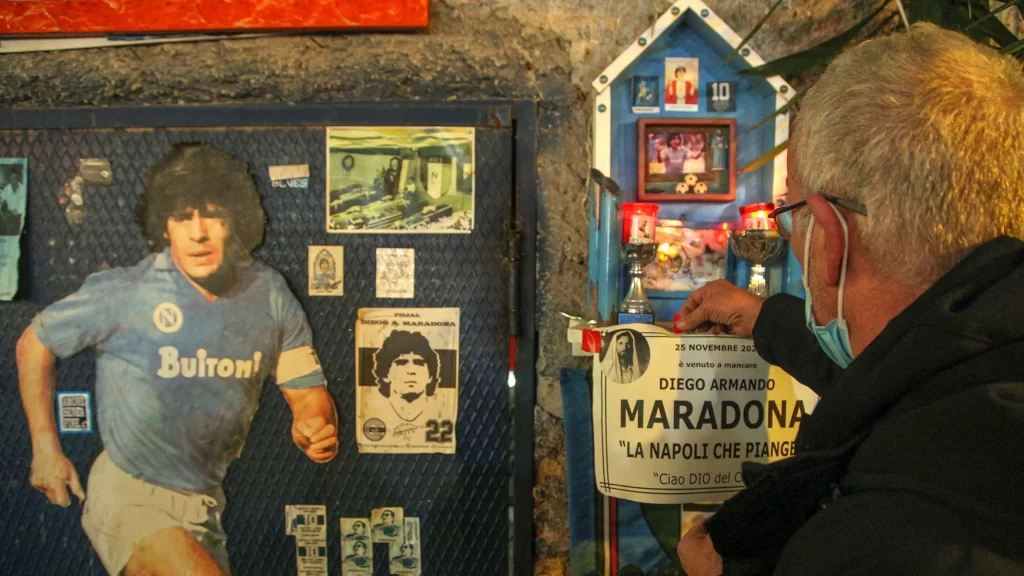
On November 25th 2020, after the passing of the Napoli Legend Napoli’s mayor Mayor Luigi De Magistris and Napoli’s President proposed renaming Napoli’s Stadium Sao Paolo to Maradona to commemorate the City Legend. In December this decision was approved by the city’s council.
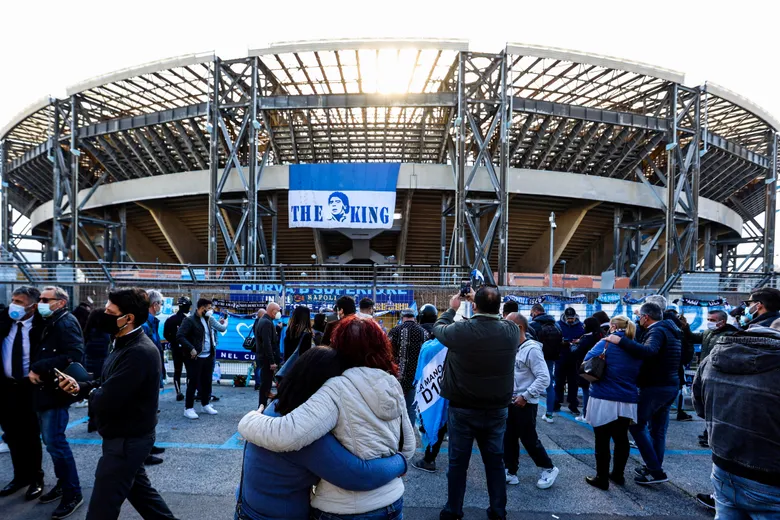
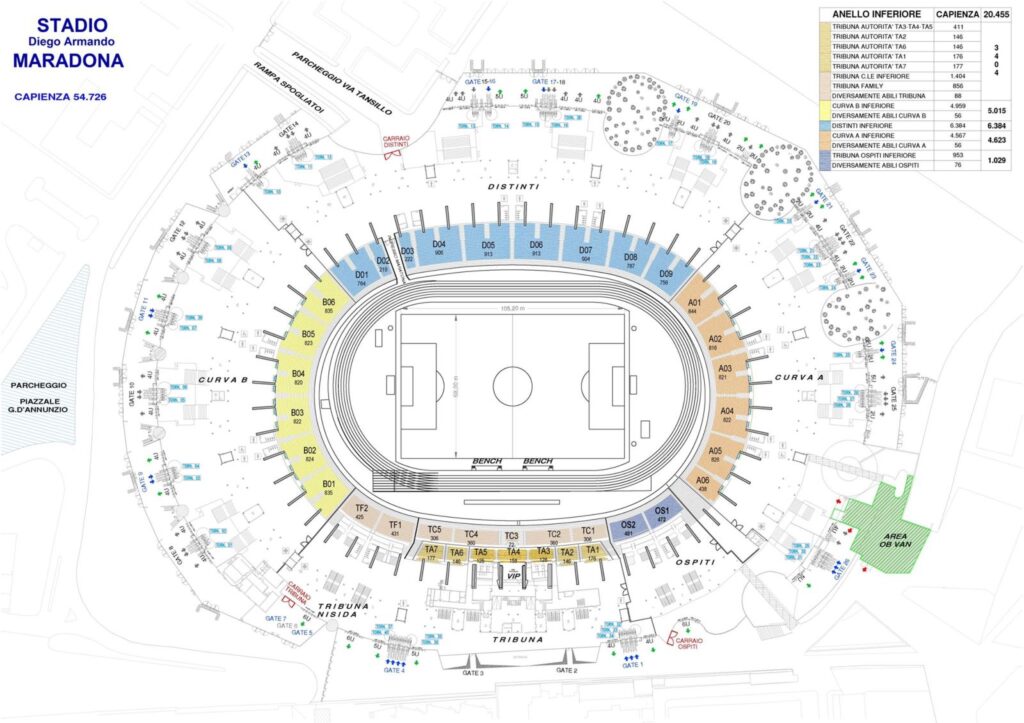
This detailed blueprint of the Stadio Maradona showcases the vastness of space it takes up. The stadium has a capacity of 54,726 and has specific deigned allocations for different spectators. As highlighted from the vibrant Curvas for the most passionate fans, to the Tribunas for the casual viewer. The Stadium is designed in a way that creates a unified community when viewing reflecting the unification of Neapolitan people and tourists alike on the peregrination that is match day
From this arial view is Stadio Diego Maradona's placement within the city of Naples. The stadium is strategically nestled within the urban fabric of Naples itself. It is placed in proximity to residential areas, as presented by its surrounding of dense urban housing. The choice of where the stadium was built reflects the deliberate choice to make it both accessible to the people of Naples and make it an integral part of the city's daily life. From this arial shot its also shown the various access points, that ensure the stadium remains a hug for everyone, we see disabled access, early, and regular all in close relation to the Maradona subway station.
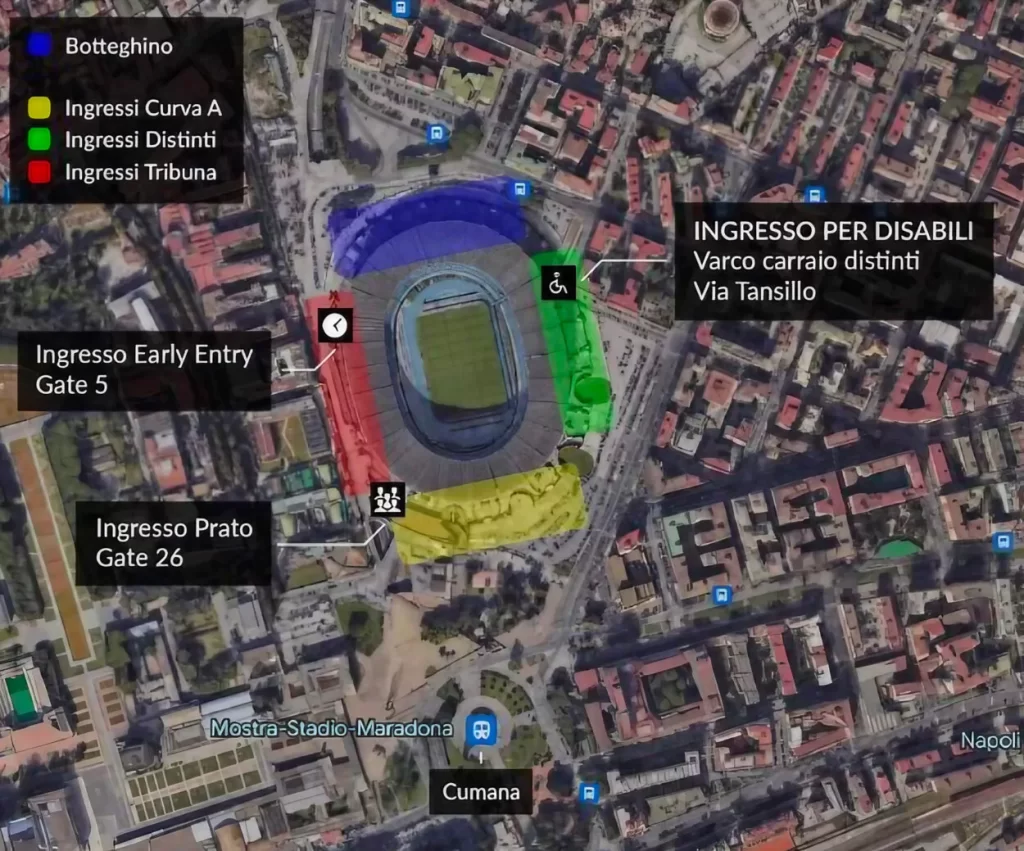
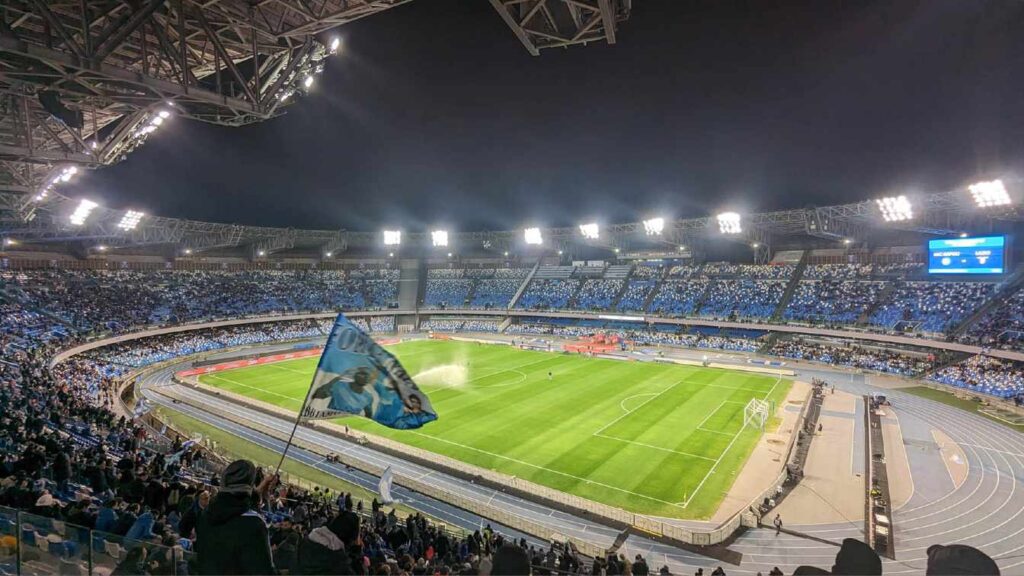
The stadium is deeply rooted in the rich history of Napoli. In the intricacies the stadium pays homage the grandeur of a Colosseum , the Neapolitan Baroque, and the post WW2 charm of Naples. However the stadium still features upgrades in its design reflecting the changes of societal needs over time such as solar panels, rainwater harvesting etc. On the picture in the left the deeply azure seats and the vibrant Napoli flags with legends raised during games are all significant parts of the local culture and identity.Source: Game Galleria
Cited Works:
- “Napoli Fans Flock to Stadium in Maradona Tribute,” The Seattle Times, accessed July 10, 2023, https://seattletimes.com/sports/napoli-fans-flock-to-stadium-in-maradona-tribute/.
- “Diego Armando Maradona Stadium: Napoli Urged to Rename San Paolo by City Mayor,” Goal, accessed July 10, 2023, https://www.goal.com/en-us/news/diego-armando-maradona-stadium-napoli-urged-to-rename-san-paolo-by-city-mayor/1cmekjo4c4r2z1o0fpgbez4ms4.
- “Stadio San Paolo,” Football Ground Map, accessed July 10, 2023, https://www.footballgroundmap.com/ground/stadio-san-paolo/napoli.
- “Diego Maradona’s Naples,” The Washington Post, accessed July 10, 2023, https://www.washingtonpost.com/graphics/world/2020/11/25/diego-maradona-naples-italy/.
- “From Naples to the World: Exploring the Iconic Stadio Diego Armando Maradona Stadium,” The Game Galleria, accessed July 10, 2023, https://thegamegalleria.com/2023/05/from-naples-to-the-world-exploring-the-iconic-stadio-diego-armando-maradona-stadium/.
- “Italy: Napoli to Remain at Stadio Diego Armando Maradona,” StadiumDB.com, accessed July 10, 2023, http://stadiumdb.com/news/2023/07/italy_napoli_to_remain_at_stadio_diego_armando_maradona.
- “History of the Stadium,” S.S.C. Napoli, accessed July 10, 2023, https://sscnapoli-web.herokuapp.com/en/history-of-the-stadium/.
- Jimmy Burns, Maradona: The Hand of God (London: Bloomsbury Publishing, 2014), https://books.google.com/books?id=UhXGBQAAQBAJ.
- “Inside Napoli’s San Paolo Stadium with Maradona.” YouTube video, 2:35. Posted by “COPA90 Stories,” July 10, 2023. https://www.youtube.com/watch?v=sLh8n6AGh6U.
- Bitner, Rhona. “Listen.” Accessed [12/10/2023]. https://rhonabitner.com/listen.
- “Gentleman Ultra. ‘Stadium Guide: Stadio Diego Armando Maradona.’ Last modified March 22, 2021. https://www.gentlemanultra.com/2021/03/22/stadium-guide-stadio-diego-armando-maradona/.”
- “Naples Died with Maradona, Napoli Fans Say,” Yahoo News, accessed March 31, 2023, https://news.yahoo.com/naples-died-maradona-napoli-fans-102709226.html?guccounter=1.
- Esposito, Alessandra. “Tourism-driven displacement in Naples, Italy.” Land Use Policy 134 (2023): 106919. https://doi.org/10.1016/j.landusepol.2023.106919.
- Bifulco, Luca. “Deifying Diego: The Church of Maradona and Beyond.” In Diego Maradona, 1st ed., 13 pages. Routledge, 2022. https://doi.org/10.4324/9781003196587-16.